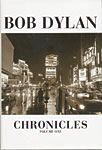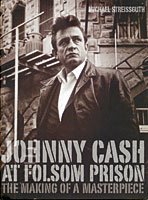The Wilco Book (PictureBox Inc.)
If you’re one of those Being There dead-enders who thinks Wilco has long since crossed the line from artsy to fartsy, you might want to pass on this. But if you quietly applaud Tweedy and co.’s courage to continually tear up the script in the pursuit of creative spontaneity and musical discovery, then this is for you. It’s a handsomely illustrated doodle pad in which band members wax poetic about the art of rock and the building blocks that make it possible, with essays by Rick Moody and Henry Miller and a CD of unreleased experimental tracks.
Cat Power, Speaking for Trees (Matador)
For everyone who’s ever walked out of one of Chan Marshall’s maddening stop-start live performances convinced she’s a basket case or a fraud, this DVD proves she’s something closer to the indie rock Ophelia. Without the leering eyes of beer-chugging hipsters to intimidate her, Marshall turns out a spellbinding two-hour performance in the woods with only the birds and the bees as her audience. Also includes the unreleased 19-minute opus “Willie Deadwilder” from the You Are Free sessions and a series of mesmerizing shorts by experimental filmmaker Mark Borthwick.
Benjamin Nugent, Elliott Smith and the Big Nothing (Da Capo)
A quickie bio set to cash in on the first anniversary of the still unexplained death of alt-rock’s most beautiful loser. Ex-Time reporter Benjamin Nugent does a decent job of tracking Smith’s tragic orbit from traumatic childhood in Texas to ski-capped Portland grunger to Academy Award-nominated troubadour to drug-ravaged suicide/murder victim at age 34. For people who like to stare at car wrecks, there’s plenty of psychic carnage here. But ultimately the sad details of Smith’s personal life are inconsequential in the face of the achingly beautiful folk-rock carols that came out of it.
 Bob Dylan, Chronicles: Volume One (Simon & Schuster)
Bob Dylan, Chronicles: Volume One (Simon & Schuster)
Robert Zimmerman finally sits down to write his back pages, and this first volume focuses on his early days couch-surfing through the beat-jazz-folk scene of Greenwich Village in the early ’60s, then skips ahead to his self-imposed post-motorcycle-accident exile in Woodstock where he commences tearing down his own carefully constructed status as generational oracle, then skips ahead to the lost years of the ’80s when the pilot light of inspiration goes out, and then fast-forwards again to the mid-’90s when Daniel Lanois helps him reconnect with his muse during the making of Time out of Mind. Maddeningly incomplete, self-serving, jive-talking and absolutely essential reading for every armchair Dylanologist, Chronicles is the work of a man who never claimed to be anything more than an unreliable narrator using complicated lies to tell simple truths.
 Lenny Bruce, Let the Buyer Beware (Shout! Factory)
Lenny Bruce, Let the Buyer Beware (Shout! Factory)
If you’re in the same boat as the young lady who asked me recently if Lenny Bruce is a new band–oy gevalt!–start with Bob Fosse’s excellent early-’70s biopic Lenny, starring Dustin Hoffman as the hipster funnyman turned free-speech martyr. Then proceed directly to this riotous near-exhaustive six-disc career overview. Bruce fought for so much more than the basic right to stand up and shout “fuck” in the crowded porno theater of pop culture. Red state puritans may not want to hear it, but children need to know about him — when they turn 18, of course. Because we should never forget that men have been crucified on the cross of the First Amendment. And Lenny died for our sins.
Grandaddy, Below the Radio (Ultra)
The downloadable mixtape has long been the gray market redoubt of hip-hoppers, a way to unify scenes outside the divide-and-commodify matrix of the music biz. Curated by Grandaddy’s Jason Lytle, this stellar comp builds an alternative electoral map comprised entirely of sad-eyed blue state Americana, including tracks by Beck, Beulah, Earlimart, Giant Sand, Pavement and a new Grandaddy song. And this time, the good guys win.
Brian Eno, Discreet Music, Ambient 1: Music for Airports, Ambient 2: The Plateaux of Mirror and Ambient 4: On Land (Virgin)
In 1975 Brian Eno was putting to tape some soundscapes for filmmaker Malcolm LeGrice when he had a eureka moment. On a whim, he slowed the tape speed and had a vision of the wordless, beatless infinite of the post-rock universe. He called this music “ambient,” and over the course of four albums — Discreet Music, Ambient 1: Music for Airports, Ambient 2: The Plateaux of Mirror and Ambient 4: On Land — Eno would essentially chisel out the Rosetta Stone by which pretty much all of electronica, house, techno and all its variants would set their collective watch. It’s Eno’s world, baby. We just listen to it in airports.
 Michael Streissguth, Johnny Cash at Folsom Prison: The Making of a Masterpiece (Da Capo)
Michael Streissguth, Johnny Cash at Folsom Prison: The Making of a Masterpiece (Da Capo)
This is a detailed picture book documenting the making of an album about life after you’ve shot a man in Reno just to watch him die. In 1968 Johnny Cash ended a five-year commercial lull spent battling his pill-fueled demons with a historic concert for the inmates locked behind the gothic granite walls of Folsom Prison. The only thing separating Cash from the rowdy throng of murderers, pimps and thieves — and surely an innocent man or two — was his trusty acoustic guitar, his cavernous baritone and a songbook that made it clear he too walked the line between sin and redemption.
Tom Dowd & the Language of Music DVD (Palm)
In the weird science of recording music, there is lightning–artists like Thelonious Monk, John Coltrane and Dizzy Gillespie — that bolts across the ether, and there are lightning rods–producer/engineers like Tom Dowd — that draw said lightning down to earth and catch it in a bottle. As a teenage GI, Dowd worked for the Manhattan Project and bore firsthand witness to the infamous Bikini Atoll A-bomb tests. He went on to engineer the more benign but no less seismic atom-splitting of Aretha Franklin, Ray Charles, Coltrane, Monk, Dizzy, Cream, Booker T and the Allman Brothers. For which you owe this man, whom you’ve probably never heard of, more than you will ever know.
John Leland, Hip: The History (Ecco)
Sage music scribe John Leland’s exhaustive genealogy of the cyclical rebirth of cool: from the plantation code words of Southern slaves, to the algebraic bleat of bebop, to the white negro beatitudes of Kerouac and Ginsberg, to the hippies, punks and hip-hoppers that came after. Required reading for all Urban Outfitters shoppers because, as Leland makes abundantly clear with his incisive prose and hepcat scholarship, it takes more than a trucker cap, an Atari T-shirt and a girlfriend with fucked-up hair to be hip. Do your homework.
 Wire, Wire on the Box: 1979 (Pink Flag Archive Research)
Wire, Wire on the Box: 1979 (Pink Flag Archive Research)
Wire was the dentist drill in the mouth of punk, burrowing deep into the enamel of rock, at times painful but altogether necessary to rid us of the cavity creeps and their hippie plaque. Wire’s spiky spartan pummel added brevity, repetition and incantation to the lexicon of post-punk. This DVD and accompanying CD captures the band live on the German television show RockPalast, performing for an audience of dazed Teutonic longhairs during their seminal Chairs Missing/154 period. Achtung, baby.
 Various Artists, Left of the Dial: Dispatches From the 80s Underground (Rhino)
Various Artists, Left of the Dial: Dispatches From the 80s Underground (Rhino)
A wise man once said that everyone worth knowing in the ’80s had an earring and a girlfriend who liked R.E.M. They also had a show on college radio, and these were the songs they played. All over the map — sonically, geographically and chronologically — this four-disc set comprises 82 alt-rock recording artists spanning a decade that lasted 10 years but felt like 120 Minutes. Trust me.
POSTED BY JONATHAN VALANIA, CONCERNED AMERICAN AT 11:45 PM

